France's greatest islands for a post-lockdown escape
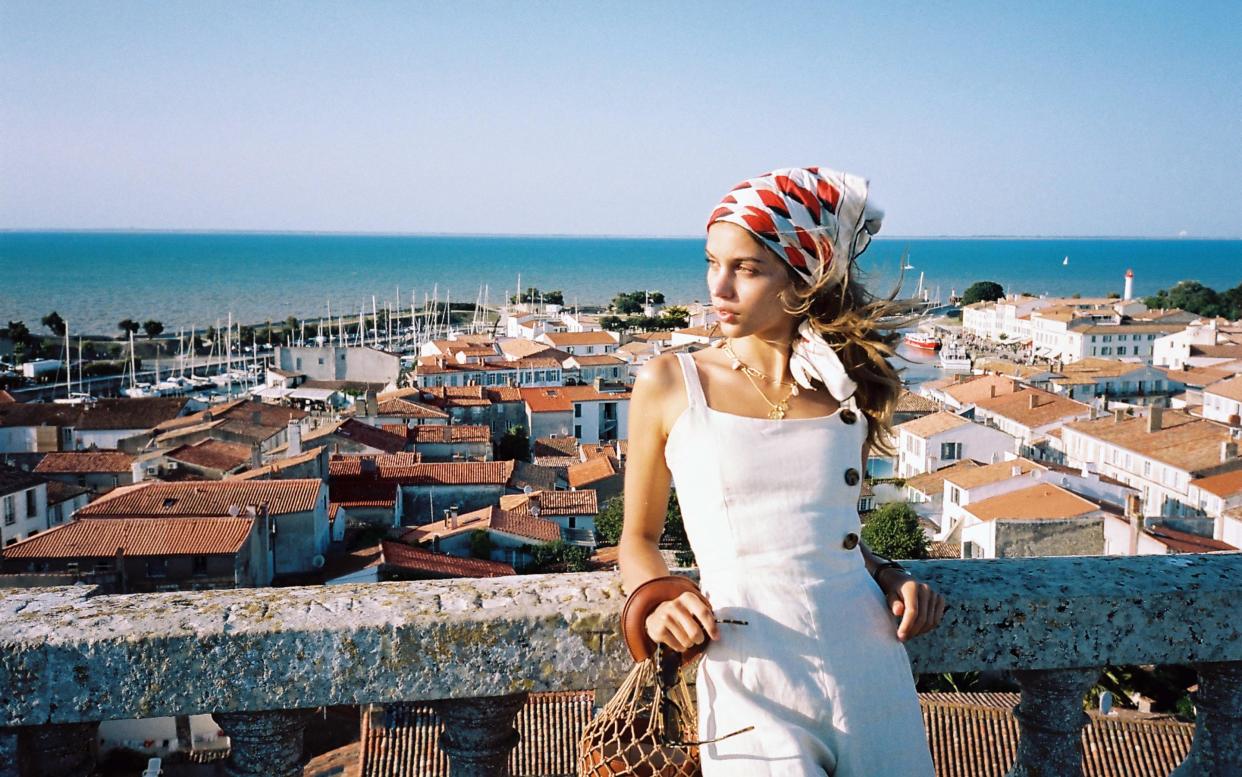
Crikey, but real islands are exciting. You’re on the big bridge across or, better yet, the ferry, and already two things happen: the pulse quickens and yet calm descends.
Mainland worries – mortgage, disease, the future of Matt Hancock – drop away. You’re going beyond their reach to self-contained worlds that run to more timeless rhythms. (That may not be how it seems to islanders – but you’re not an islander. You’re on hols.)
This is particularly true of France’s best islands, which, circumscribed and easy to control, have generally not submitted to rampant development or the raging demands of 21st-century entertainment. If you need a 25th-floor penthouse apartment or to groove through to dawn amid cod tropical decor, you’re going to have to be somewhere else.
Instead, we have a great deal of nature, and people who live and work with it – fishermen, oyster producers, salt workers or descendants of stout women farmers. Within living memory, certain of the bigger Atlantic islands boasted residents who had never seen any reason to visit the mainland. These sorts of people are not big on discos.
Here, instead, be headlands, forests and outstanding beaches – including, on Porquerolles, my candidate for the best in France. The elements may cut up rough, notably on Ouessant, where the wind might blow your legs off. But they also bring calm and beautiful moments – often enhanced by the discreet hand of man.
And the fish! I once ate so many scallops and assorted shellfish on Breton islands that I was reclassified as an aquarium. I wish you such happiness.
Belle Ile, Brittany
Pop: 5,200; 33 square miles
In 1894, Sarah Bernhardt – the most sulphurous actress of her era – visited an abandoned Belle Île fort at the ocean-ravaged Pointe des Poulains headland. Within hours, she’d bought it. She spent her last 30 summers there, building associated accommodation for visitors, assembling a menagerie (12 dogs, a chameleon, an owl, a boa, a crocodile, a monkey, a parrot called Bizi-Bouzon) and hosting fêtes sauvages – wild parties – with, among many others, our Edward VII. In a 1904 interview with the Telegraph, she explained: “I love Belle Isle for its solitude, its silence, its wildness … for the dreams, the ideals and the beauty I find there.”
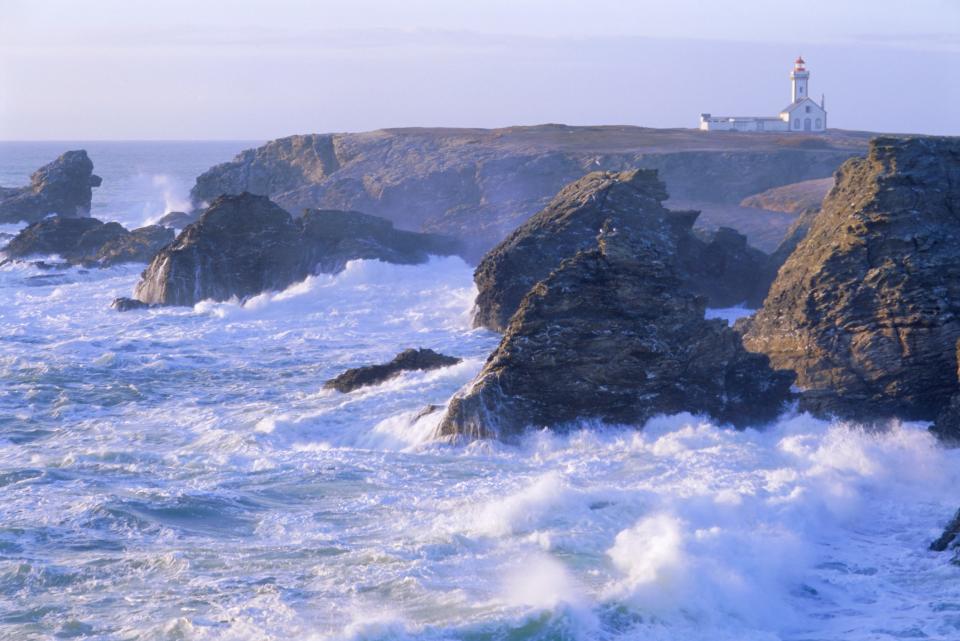
The island is much busier these days, but Ms Bernhardt’s words mainly hold good. You land at Le Palais, 45 minutes off Quiberon, visit the citadel above (if you’ve never visited any other French citadels) and then get out along the calmer north coast. Here be the best of the 58 beaches, plus dinky little port villages like Sauzon. The south and west coast is craggier and creekier, with cliffs, sheer-sided inlets and, just offshore at Port Coton, the rock needles painted six times by Monet in 1886.
I have cycled Belle Île – there’s a lot of farmland in the middle – reflecting on the fact that it once belonged to us. Our troops stormed the citadel and took the island in 1761, during the Seven Years War. We gave it back two years later, in exchange for Minorca and most of French Canada, which seems to have been a jolly reasonable deal. I’d not mention this, as it’s likely to offend. Instead, visit Ms Bernhardt’s old premises – they’ve been restored as was and it is an exhilarating spot – before maybe dining back in Le Palais at AO, where chef Haruka Casters has, since 2018, been giving island cuisine a Japanese accent (0033 628 341508; aobelleile.com).
Where to stay: In the south, at Bangor, La Désirade is a welcoming spot and good base for exploration. After three nights, room rates reduce (hotel-la-desirade.com; doubles from £115).
Porquerolles, Provence
Pop: 200; five square miles
Almost all islands have beaches. They’re surrounded by water, so why wouldn’t they? But Porquerolles, 20 minutes off the Giens peninsula, has the best, the very best, in France. I’ve claimed that so often that it writes itself, but it remains true. Plage Notre-Dame – a 15-minute cycle ride or 30 minutes on foot from the port-village – is a ravishing curve of white sand with sea both limpid and brochure-blue out front, pines, myrtle, rosemary, eucalyptus and other aromatic items behind.
It’s the star attraction of an enchanting nugget of rocks, vines and forest hacked off the mainland and chucked out to sea. The village may have an epic summer bustle (what did you expect? You’d have this place to yourself?) and its main square the air of a parade ground, as favoured by Beau Geste. No surprise: the settlement was established as a 19th-century retreat for colonial troops. But the military aspect is softened into Provençal shape by oleander, bougainvillea, bar terraces and a merriment of holiday retail.
Shortly, anyway, you walk or hire a bike and take to the tracks away from development, past vines and olive groves and on to an island wildness of maquis, forest, creeks and soaring headlands to the south. Porquerolles has been fashioned by the hand of man since the Etruscans. If it now looks untouched, that’s because the hand of man has intruded to stop intrusion. National park rules don’t mess about. Promontories like the Calanque de l’Indienne remain, thus, pristine.
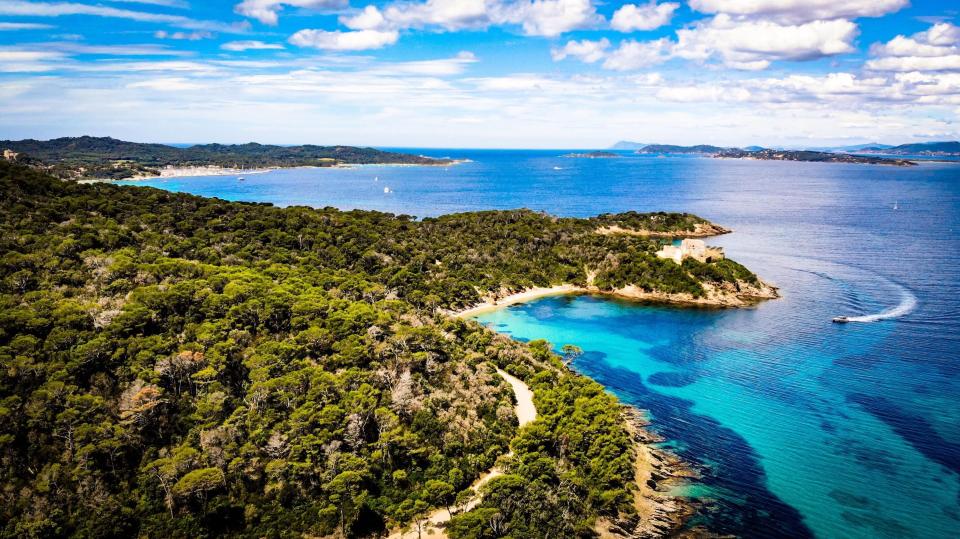
The northern side softens to Notre-Dame beach but also the Plage-d’Argent, the only stretch with a beach restaurant: a good one, too. Meanwhile, the Plage de la Courtade has the kayaks and stand-up paddles – plus, behind, maybe the island’s best winery, Domaine de la Courtade. In recent times, the Fondation Carmignac has, nearby, opened a most startling contemporary art gallery nearby. You could, in short, spend a week here – notably if you like sailing, diving or idling. But steady with the smoking. It’s OK in the village, but beyond, well, a carelessly thrown fag end could set the tinderbox summer island alight, destroying 156 different plant varieties, 623 species of insect, seven sorts of bat and several hundred tourists, including yourself. Think how silly you’d feel.
Where to stay: If loaded, make for the Mas du Langoustier, an isolated outpost of luxury on the island’s western coast (langoustier.com; half-board from £148). Otherwise, the Villa Sainte Anne, owned by the same family, in the village is lovely enough (sainteanne.com; doubles from £85).
Batz, Brittany
Pop: 450; 1.2 square miles
Such is the luminous welcome from among the neat stone cottages and gardens of the village that the visitor is tempted to knock upon any door in the expectation of cake and tea. Of course, the visitor doesn’t, for he or she is not deranged, but the ambient serenity makes it an enticing idea. The Gulf Stream warms the island, just off Roscoff, sufficiently for a gaiety of flowers (they enliven the grey admirably; it’s Arnside-meets-St-Raphaël) and a swathe of organic farming. Batz is an agricultural atoll. Carrots, cauliflower, fennel, you name it: chuck down a seed here, you’ve got a crop tomorrow.
Especially spuds, grown under a mulch of seaweed, ripe a month earlier than on the mainland and as delicate of taste as a potato can be. The functioning mini-economy gives a rooted feel to an island of people who, mainly, would be doing what they’re doing even if tourists never turned up. Which is a good reason for turning up. Another is the subtropical abundance of the Delaselle Gardens, undoubtedly the greatest in France ever established by a former insurance agent (jardin-georgesdelaselle.com). Beyond field and garden, Batz cedes to heathland punctuated by heavy horses, a shaggy shoreline whittled from rock, and beaches like the 800m white-sand Grève Blanche – where I’ve picnicked entirely alone in mid-August.
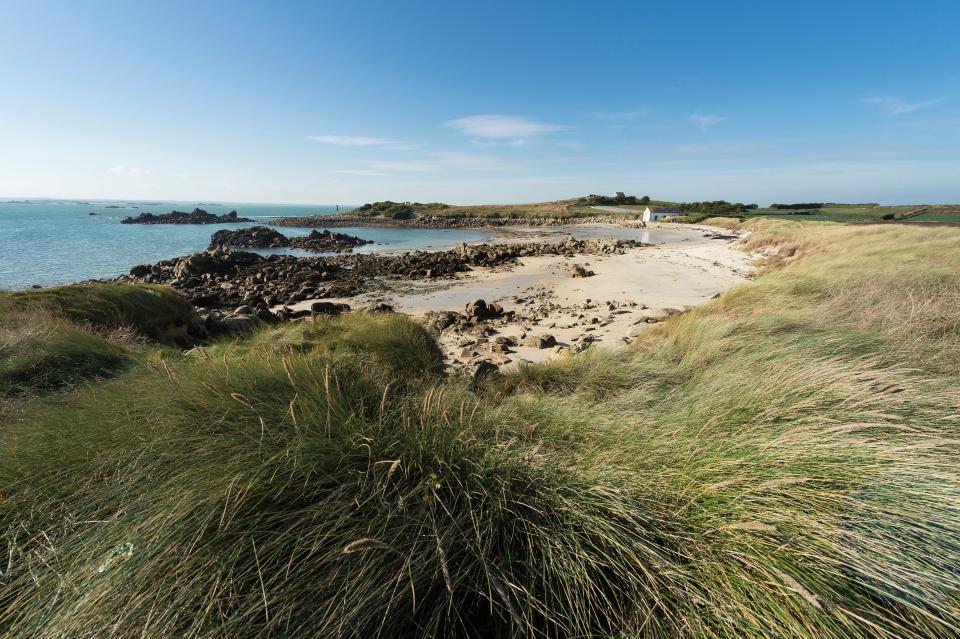
Then I returned to the village and a café. “Play your cards right,” I said to the waitress, “and I might even move here.” “Play your cards right,” she replied with a smile as wide as the Channel, “and we might even let you.” Batz is, incidentally, pronounced “Ba” – as in black sheep, rather than belfry.
Where to stay: Les Herbes Folles hotel is simple, by the quay, and equipped with a good bar and restaurant (hotel-iledebatz.com; B&B doubles from £66).
Noirmoutier, Vendee
Pop: 4,600; 19 square miles
A year or two back, the night before I crossed to Noirmoutier, the criminal classes broke into my car and stole the CDs. It was thus without Tina Turner, Janis Ian or Mott the Hoople that I arrived. I was distraught, but not indefinitely. Like France’s other Atlantic isles, Noirmoutier has a calming effect. Arrive by the bridge or the three-mile causeway (for God’s sake, check the tides first) – and you ease into a more tranquil time when worries about Mott the Hoople weigh less heavy. Villages, their houses whitewashed and trimmed with blue shutters and hollyhocks, promote sunlit placidity.
Long beaches, backed by dunes enlivened by tamarisk and dune pinks, cede to woodland. Near Noirmoutier-en-l’Île, the Plage des Dames may be best for beach life. Certainly, the soft sand, white beach huts and La Potinière beach restaurant (renewed in 2019) do it no harm. The island’s flat, so cycling’s the other thing, by the seaside and the salt pans, fuelled by village markets and some notable churches.

Then you eat. Noirmoutier is gaining a name for decent vittles. It’s always had the spuds, shellfish and more salt than is presently deemed necessary. Now it also has the cooks. Alexander Couillon has two Michelin stars at La Marine in L’Herbaudière – plus a more affordable bistro, the Table d’Elise next door (alexandrecouillon.com). Henrik Garriga and José Roche have brought Le Grand Four to eminence (legrandfour.com) while the Fleur de Sel is as toothsome as ever (fleurdesel.fr).
Then your time’s your own. You might like to ponder the fact reported by Noirmoutier regular and Chocolat author Joanne Harris: that, when she was a child visiting grandparents here in the 1960s, there were “still people who had never left the island”. It is indeed a great place but never ever to have left even once seems sad. Ms Harris anticipated the problem by being born in Barnsley.
Where to stay: The Fleur-de-Sel, with gardens and summer terrace on Rue des Saulniers, remains the classic address (fleurdesel.fr; B&B doubles £85).
Ile de Re, Charente-Maritime
Pop: 18,000; 33 square miles
The Île de Ré is chic. Really chic. The chicest of all France’s European islands. Over the two-mile bridge from the mainland, there are 10 villages, 16 long beaches and quite a few people you’ve half heard of.
Orlando Bloom and Katy Perry apparently frolicked there last summer. Former French prime minister Lionel Jospin is a regular, as are a whole raft of other very famous personalities unknown beyond France’s frontiers, and as was Sonia Rykiel. Ré is, in short, the French Hamptons, as someone cleverer than me once said.
There are reasons. There’s the whitewashed, blue-shuttered tranquillity. Island capital St Martin de Ré has its cobbled side streets crammed into the star-shaped citadel. Beyond, it’s cycling time again. With Ralph Lauren sweater draped about the shoulders, one pedals the paths via vineyards, dunes, stone-walled fields and salt pans to Ars-en-Ré with its black and white-spired church and Conche des Baleines beach. Or to La Flotte for the island’s loveliest market – in a medieval courtyard.
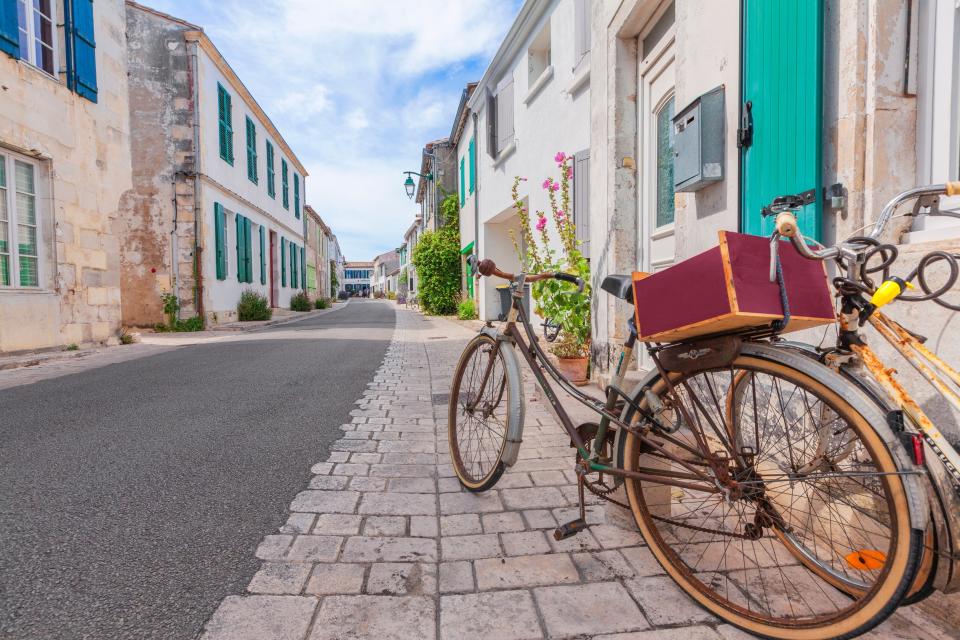
The Plage de la Pergola at La Couarde-en-Mer might be the place for you, should you fancy surfing. Or maybe you prefer oysters – from, say, Cabanajam oyster shack on the St Martin seafront. The real see-and-be-seen scene is on the quays around St Martin’s port, where bars and bronzed beauty gather but without the gold chains or Ferraris of the Riviera. Subtle, lounging smart is the attitude to adopt. Or don’t bother adopting any attitude but simply stroll around in your usual manner.
Should the stroll bring you to the Tout du Cru on Quai Job Foran, I doubt you’ll be disappointed with the cabin decor or available shellfish (tout-du-cru.fr). Book ahead on 09 52 90 6000, for the place is small and you’ll not be the only person strolling that way. The name, incidentally, is a scatological pun. Don’t ask for an explanation or it will put you off your cockles.
Where to stay: Best value in St Martin-de-Ré is maybe the three-star Galion (hotel-legalion.com; doubles from £89).
Brehat, Brittany
Pop: 360; 1.2 square miles
You want flowers? Get thee to Bréhat, 10 minutes off the north Breton coast, near Paimpol. On arrival, you’ll realise at once why the island is known as the île aux fleurs. The place is alive with a sense-smacking mix of hortensias, geraniums, camellias, agapanthus – and others besides – all dressing the stone island village in spring and summer loveliness. Amid gardens and cottages, down-home commerce and car-less tracks and lanes, you might reflect that this is the way the whole world should be.
Then you might go to the beach: Guerzido is the best-sheltered. Best all round, really. Then stroll from the village to the northern bit of the isle, the flipside of tranquillity where both coast and heathland grow feistier.
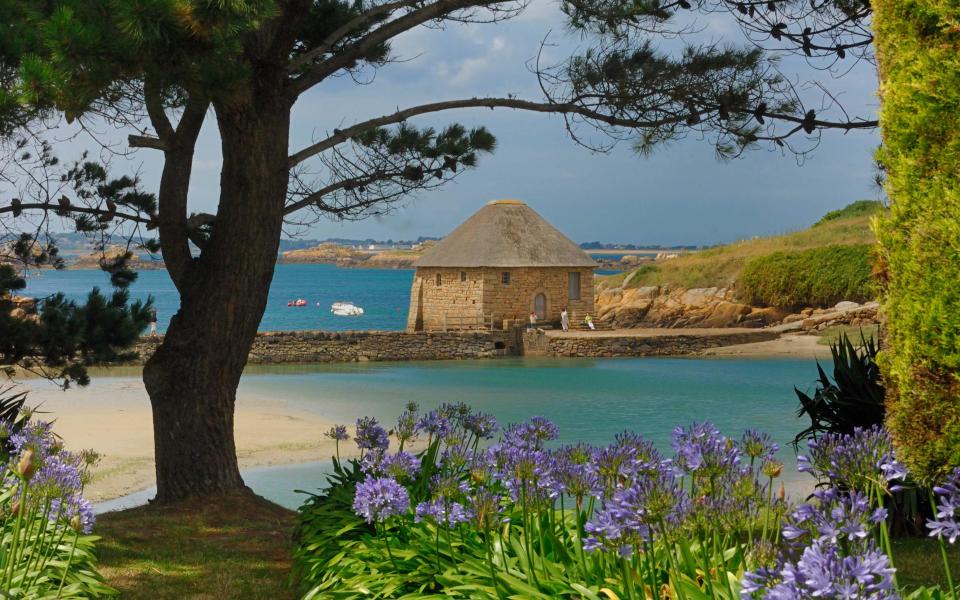
The Paon lighthouse is right at the tip, emerging from the pink granite rocks. Nearby is a chasm (gouffre) in the same rocks. Women interested in their marriage prospects should take a little stone and chuck it down the chasm. If it reaches the bottom without bouncing off the sides, you’re to be married within the year. Should it bounce off the rocks, the number of bounces is equivalent to the number of years you’ll have to wait. I don’t see how things could be clearer.
Depending on the verdict, you might celebrate with a drink and a crêpe in the garden of the Paradis Rose – the sole café on this bit of the island – or return south, where the 12th-century tide-driven Birlot mill may take your mind off things.
If that doesn’t work, and I can see that it might not, try the glassworks in the island’s citadel. They make some remarkably pretty and contemporary stuff (verreriesdebrehat.com).
Where to stay: The recently renewed Hotel Belle-Vue overlooking the port. Good restaurant, too (hotel-bellevue-brehat.fr; doubles from £93).
Ouessant, Brittany
Pop: 830; six square miles
If Ouessant – tough, weather-beaten, resistant, at the far end of Brittany and therefore of Europe – was known as the Women’s Island, that’s because women were largely in charge… and plenty tough, weather-beaten and resistant themselves. “Big and strong and well-planted on solid legs,” was how a 1945 visitor described the island’s distaff side. They hadn’t much choice.
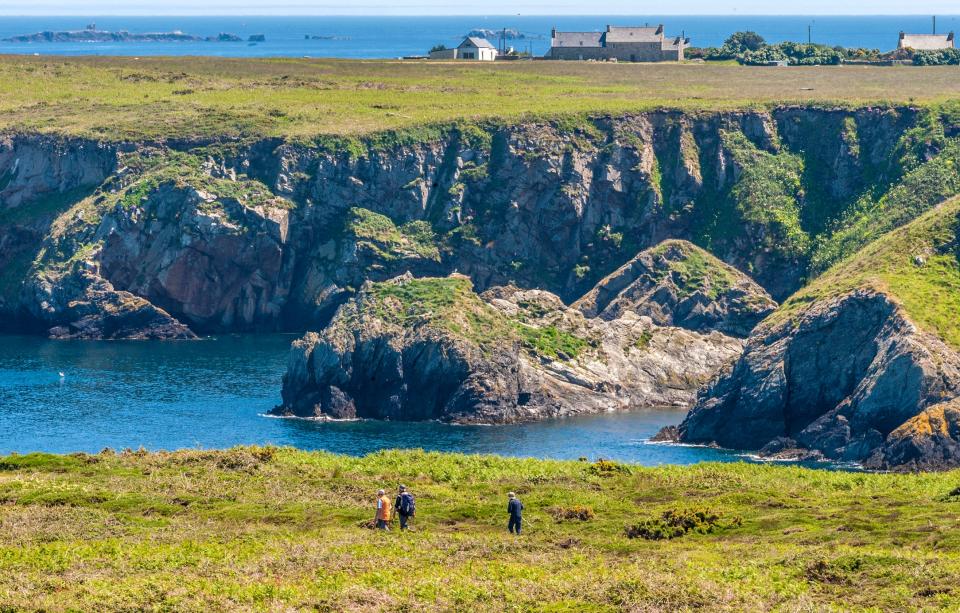
Their menfolk were away at sea, often for years at a time. The women hunkered down for hard lives lived low on this serrated, wind-blasted island abandoned by trees aeons ago. Stone walls still mark out fields two-strides wide. The women grew crops and raised the miniature black Ouessant sheep. From chaotic shorelines, they gathered seaweed and driftwood (some still do: if the attractive bit of wood on the shoreline has a stone placed upon it, leave well alone: it’s already been bagged.)
Such farming is now mainly a memory, leaving the wildest of isles (“Ushant” in English) unspoilt for visitors after their hour-long crossing from Le Conquet. The key thing is to pick up a hire bike on landing at Port du Stiff (book on cyclevasion.fr; £11.70/day) or trust to your legs to roam the heathland, then the cliffs, creeks and headlands of a coast hacked about by a vengeful deity.
Here and there, it grants small beaches: Corz and Prat are the best. Bird life abounds, and there’s a bracing sense that nature could do with you whatever it damn well wanted, whenever it chose.
Ouessant is close to the busiest shipping lanes in the world. Its currents and rocks bring boats to grief with alarming regularity. (The five lighthouses, including Europe’s mightiest, the Créac’h, are scarcely a luxury.) If capital Lampaul smiles in summer clothing – cafés, gift shops, gardens – it’s granite underneath. And the elements will be blasting your hair off tomorrow. Stirring, is the word.
Where to stay: Recently reopened, the Roc’h Ar Mor (also with a good restaurant) is by the sea in Lampaul (lerocharmorouessant.bzh; doubles from £49).
Sein, Brittany
Pop: 250; 143 acres
In France, the tiny isle of Sein is best known for responding to a radio broadcast – specifically, General de Gaulle’s June 18 1940 BBC appeal for Frenchmen to join him in London. Sein men were gathered around one of the island’s few radios. Ultimately, 130 of them set sail for, and arrived in, the British capital. There were, at that moment, some 500 French refugee-volunteers in total in London. “So Sein accounts for a quarter of France, does it?” said the general.
This wasn’t so remarkable. Sein people had been rescuing people in peril on the seas for centuries. As island historian François Hervis said: “For de Gaulle, it was the same. He called for help. Our men went.” Sein is, though, a remarkable enough island. Rising barely 5ft above the sea an hour off Audierne, it’s like a floating tray bearing a village of white, yellow and blue houses and streets sinuous enough to confound the wind and spray. They do not, however, confound seagulls. In Sein, they will steal your chips if you sit on the sea wall. And they don’t hang around long enough to be hit. Believe me.
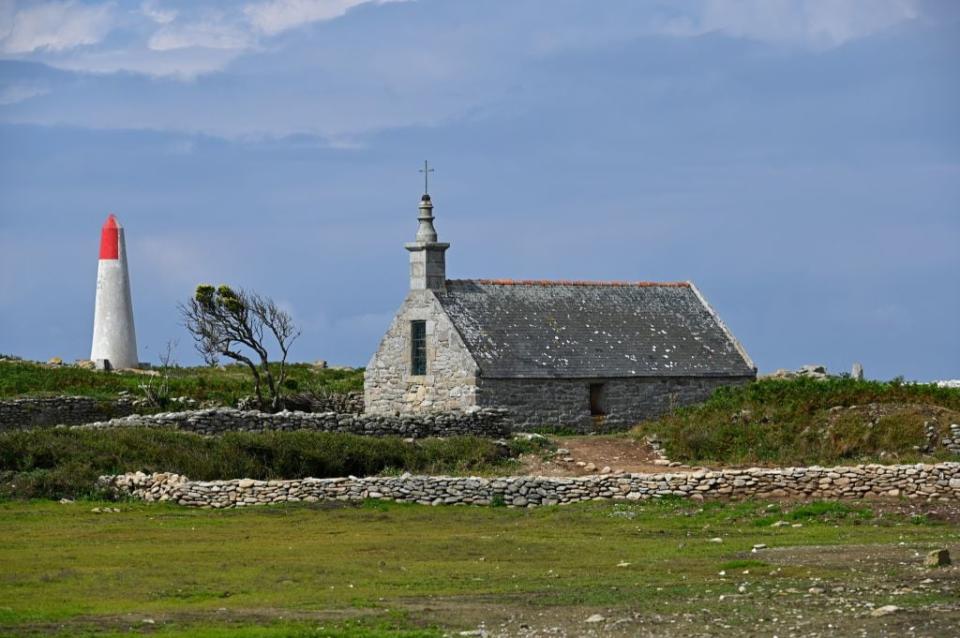
That said, there’s a nice little beach and, beyond, rolling coast and heathland of which you’ve done the bracing tour in an hour or so. Look out for graveyards (including those of British and French seamen come to grief in the Great War) and, especially, the monument to the Free French Forces, unveiled by de Gaulle on a 1960 visit to the isle in honour of Sein’s wartime valour. It’s between the village and the Goulenez lighthouse. The Breton inscription reads: “Kentoc’h marvel” (or “Better to die”).
Then return to the village for the local lobster stew speciality – maybe at the Hotel-Restaurant Ar-Men (hotel-armen.net). Book the dish ahead, and be prepared to pay 50 quid a head. There are, though, cheaper options.
Where to stay: Hotel d’Ar-Men has doubles from £55, half-board from £115 for two (hotel-armen.net).
Oleron, Poitou-Charentes
Pop: 23,000; 68 square miles
Ah – the oysters. But first, the facts. You need to know that this is France’s second-biggest European island, after Corsica. There’s a two-mile bridge to get in and out. Once there, Oléron offers much the same as the other Atlantic islands, just more of it: marshes, salt pans, pinewood-backed beaches (the greatest runs from Vert-Bois to the island’s southern tip), a citadel at Château-d’Oléron, comely villages of white and blue, markets and as much cycling as God-given thighs can manage. As elsewhere, leaving the mainland for the island means casting off from the 21st-century for a halcyon time when life was less annoying. And if there are more cars here than on Ré or Noirmoutier, don’t complain: it’s probably as much your fault as anyone else’s.
That said, what Oléron has, and the others don’t, is a stake in Europe’s finest oyster park. The oysters of the Marennes-Oléron basin (Marennes being opposite Oléron, on the mainland) are rated aristocrats among bivalves. They are fleshy, they are good and may be sampled, with a glass of Bordeaux white, in the oyster villages around Le Château d’Oléron. Try the shacks at Ors or La Baudissière. And remember: fine de claire means the oysters have been grown at sea but finished in the claires, or former salt pans. These form a mosaic across the watery landscape. Pousses en Claire oysters spend all their lives in the claires, thus becoming the crème de la crème of molluscs.
Once full of oysters (and, please, chew them at least twice; don’t simply slurp them down) you might divert to the tiny, nearby island of Aix, from where Napoleon was carted off to exile in St Helena. He thought he was bound for a comfy berth in Britain. The former governor’s house, where Napoleon spent his last days on French territory, is now a museum, telling the sorry story (musees-nationaux-napoleoniens.org).
Where to stay: Hotel l’Océane near the port of La Cotinière for breathing space two pools (inside and out) and warmth (hotel-oceane-oleron.fr; doubles from £83).
Frioul archipelago, Provence
Pop: 146; 480 acres
Of these islands 20 minutes off Marseille, If is the best-known. You will recall that it was from the fortress prison which colonises the island that the Count of Monte Cristo escaped. On visiting, you may be shown his cell. This is surprising given that, as you will also recall, the Count was fictional. Ah well. You’re among Marseille people.
And then there was this rhino. A real rhino, apparently. In 1516, the animal was being shipped to Rome as a gift from the king of Portugal to the Pope. It was put ashore on If as its transport ship sheltered from a storm. French king François I, who was nearby, galloped along specially, for he’d never before seen a rhino. (The ship sank on its onward journey. The rhino drowned, but its carcass was retrieved. Thus the Pope still got a rhino, but a stuffed one, which doubtless proved a lot more manageable around the Vatican.)

During his visit, King François ordained that If be fortified, which is why it was later available for the Count of Monte Cristo not to be imprisoned in.
Having dropped some passengers off there, the ferry from the Vieux Port continues to the bigger islands of Ratonneau and Pomègues. The two are joined by a dyke. Beyond the little port on car-less Ratonneau, one strides around creeks, sun-roasted rocks and beaches of white-sand loveliness.
On a promontory stands the old Caroline isolation hospital, once used for quarantine to keep disease out of Marseille. It affords a remarkable perspective back to France’s greatest port – which, from here, looks both overwhelming and humbled by sea and sky.
Where to stay: No hotels or B&Bs, so seek out Frioul apartments or boats to rent (airbnb.fr or abritel.fr).
Ile des Embiez, Provence
Pop: a handful; 235 acres
Drinks magnate Paul Ricard – the pastis man – bought two Med islands in the 1950s. The company still owns them. Off Bandol, Bendor is small, like an offshore country estate, and lapped in 30 minutes. Ile des Embiez is bigger and well worth the 15-minute ferry from Six-Fours-les-Plages. Back from the port, there’s a facsimile Provençal village – shops, cafés, a winery, a general air of ambling farniente – plus a four-star hotel.
Now, this being a businessman’s island, you’d think that it would have been concreted over for the purposes of profit. You’d be wrong. Ricard was an ecologist well before everyone else caught up. Thus, beyond the village, the island has been left to go wild in the Mediterranean manner: garrigue scrub, creeks, headlands, eight little beaches (Plage des Allemands is the most easily walkable, Plage du Rix maybe the prettiest but damned difficult to climb down to) and as much Med flora as you like.
Then return to the village for playtime: tennis, pétanque, archery, diving. In truth, you might find Paul Ricard’s presence overbearing – posters and signs announce his achievements a little too forcefully. The French don’t invariably get the hang of modesty. That said, Ricard did get the hang of philanthropy – on a macro-scale, ensuring all his workforce had work to retain them during the last war and, on a micro-scale … well, as an Embiez barman explained to me: “Mr Ricard came into the bar towards the end of one summer season, asked how I was. I said, ‘OK, but a bit tired now.’ He left, went back to his office and, within the hour, had sent me two tickets for a fortnight’s break in the USA.”
So – all that, and pastis, too. There’s really no arguing with the fellow. Or his island.
Where to stay: Hotel Helios has four-star style and a spa, sufficient for a weekend (lesilespaulricard.com; doubles from £152).
Iles de Lerins, Provence
Ste Marguerite: pop 20; 520 acres. St Honorat: pop 21; 91 acres
It’s stupid but true: you can’t visit both inhabited Lérins islands in one round trip from Cannes. You must sail to one, return to Cannes and then catch another ferry to the other. Sadly, the islands are really only worth one trip, so you have to choose.
Further out and smaller, St Honorat has been run by monks for 1,600 years. Now it is home to Cistercians – unworldly fellows who, having rejected materialism, live on one of the most expensive stretches of real estate in Europe, doing God’s work of knocking out wines and spirits at prices accessible only to those who have made vows of wealth.
At the island’s tip, there’s the original monastery, fortified against Saracen raids and now in ruins. Visit that and the more modern monastery shop for the wallet-busting plonk, and that’s your lot.
St Marguerite, by contrast, has a fort as interesting as any on the French isles. You may visit cells where Protestant clergymen were banged up during the wars of religion – and also that which harboured the Man in the Iron Mask, gaoled here for 11 years from 1687. Still no one knows who he was, though there are some 60 serious suggestions – including financier Nicolas Fouquet, Molière, a son of Cromwell and, my favourite, Nabo, the dwarf slave of Louis XIV’s queen, Marie-Thérèse. Nabo allegedly got Marie-Thérèse with child, and so had to be banished. The mask (almost certainly in velvet, not iron) presumably served to disguise him among all the other dwarf prisoners.
Across the Fort Royal courtyard stands a museum of marine archaeology which is interesting for those interested in marine archaeology. Others might prefer to stroll the rest of the island. It’s mainly flat, unchallenging but lovely woodland – more an offshore park than a forest. Here and there, the gentle coast grants little beaches and spots for picnics.
Meanwhile, on the south side of the isle, you may pass before the 3.5-acre, walled Grand Jardin domain. The island’s only private property, with its 17-bedroom mansion, was bought in 2008 by brewery billionaire Vijay Mallya. Subsequently, Mr Mallya has allegedly run into financial turmoil. The domain is said to be for sale. If you have perhaps £30-£40 million to spare, you could definitely do a lot worse.
Where to stay: The only accommodation on the islands is as a retreat among the monks of St Honorat. You take your own sheets, share the life of the brothers, eat in silence and pay what you think fit. Minimum two nights, maximum a week, for men, women, couples or groups. Contact hotellerie@abbayedelerins.com.


